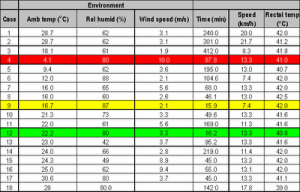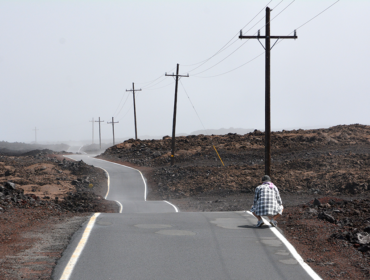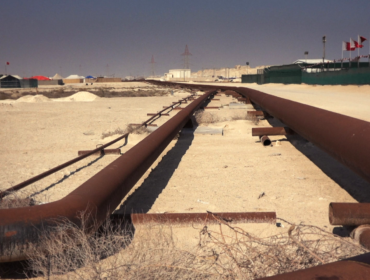In this post I would like to come back to the problem of exercising and racing respectively in the heat. Also this text refers to a publication on the blog of »The Science of Sport«.
Especially in exercise science over-heating is primarily outlined as induced by the environment: bright sunshine with high temperatures, high humidity and dehydration. All documented reports account for other reasons than environmental ones. Even though the view that heat stoke is a cause of hot weather is prevailing doggedly. Just recently when I have been at the triathlon world championship in Kona on Big Island, Hawaii, heat and humidity has been the big issue. It has become a major topic of the pychological warfare taking place around this tough race.
Nobody can doubt that the environmental conditions there are extreme, nevertheless heat stroke is not a common problem among the athletes. To raise your doubts concerning the well accepted scientific concept of heat stroke and temperature regulation I want to draw your attention upon the fact how different various people perceive temperature. There are those who dress with short sleeves and a sleeveless jacket even if the temperature is a good deal below 10°C and there are others who feel chilly if the thermometer displays comfortable 20°C and above. And moreover, it is common sense that our feeling for temperature is not a stable constant condition but changes depending on our body’s condition. His ability to regulate and adapt the weather situation is only one variable and obviously not of such crucial importance (the fact of heat loss, production and storage is certainly there, e.g. evaporization, radiation and convection)
I think when it comes to thermoregulation in the cold insulation becomes central, nevertheless excessive endogeneic heat production and »heat stroke« may be possible. Of course, we won’t use this term, but the phenomenon remains the same, I suggest.
But now back to the article of Ross Tucker and Jonathan Dugas. Thermoregulation they state is a far more complex physiological phenomenon than a simple balance between heat loss and heat production.
»The problem with heatstroke – a glitch in the balance«
The cases they describe punch holes in the normal theory for heatstroke (see previous post from Nov. 4 and 5).
The key to understanding heatstroke is to recognize that when heat loss potential is greater than heat production, the athlete should not develop heatstroke. Every single one of the people mentioned had a potential for heat loss that exceeded the amount of heat they would produce from exercise. Therefore, these cases of heatstroke should never have happened, unless the equations are wrong (they aren’t!), or unless something else, unaccounted for by the concepts, is causing the problem.

And therein lies the crux. These mathematical models for predicting heatstroke are clearly not “complete” for these individuals. The fact that these 16 runners and cyclists did develop heatstroke means that somewhere, either heat production or heat loss has been incorrectly accounted for. Broadly speaking, there are two possibilities: Heat production is actually a lot higher than is calculated by the equations.
This is not because the equations are wrong, because in 99.99% of people, they are relatively accurate, and certainly, the calculation for heat produced during exercise is well-established. However, in these people, something has gone wrong, and it may be that they have produced heat in large quantities from non-exercise related sources. In their recently published paper in Medicine and Science in Sports and Exercise, Tucker und Dugas called this “excessive endothermy”, which basically means heat production from within.
Still, where this heat comes from is anyone’s guess – perhaps the runner’s efficiency is massively reduced for metabolic reasons? Perhaps there is a sudden increase in heat production thanks to unregulated opening of calcium channels? There is a condition known as malignant hyperthermia, where certain chemicals, most notably anesthetics, cause calcium channels in muscle to open. As this calcium is then transferred back into storage, it uses up a great deal of ATP and generates quite enormous quantities of heat.
The malignant hyperthermia linked has been looked at before – there are reviews on the topic. They distinguish between exertional heatstroke and malignant hyperthermia, but don’t rule it out, mainly because when we look at people who suffer from heatstroke, they tend, in many cases, to be susceptible to malignant hyperthermia as well! In other words, there is likely a genetic link that predisposes people to these conditions. It has been suggested that heatstroke sufferers have a skeletal muscle abnormality that is similar to malignant hyperthermia.
Is it possible that exercise-induced heatstroke involves a similar “wasteful” use of energy in order to correct some kind of channel disruption? It may be that there is excessive sympathetic nervous system activation, triggered by a metabolic condition or muscle myopathy. Another possibility is illness – a bacterial infection before exercise may increase the chances of overheating, though this has never been confirmed (for obvious reasons), and relies mostly on retrospective analysis of specific cases (and not all cases either, it’s worth noting).
This is a remark from my side: Impaired immunity could make us prone to increased endegeneic heat production.
Certainly, hot environmental conditions may be a trigger – the role of the environment in all this should not be neglected, and it seems feasible that on a hot day, some “trigger” exists that may cause this same excessive endothermy to occur. The point that the authors make, however, is that the environment is merely the stage for the drama to be played out on – there is a pathological process at play here, and environment is not the cause of heatstroke, merely a roleplayer.
The Conclusions by Tucker and Dugas are:
However, it seems more likely that the problem is excessive heat production, and not reduced heat loss. Or, alternatively (to sit on the fence), it is possible that heatstroke is a generic term that actually describes a »condition not a cause or diagnosis (changed by myself)«.
I think the term symptom is not exactly correct, it is more a state of the body as a system.
Back to the original text:
If this is true, then it could be caused by all of the above, or any one of them! There may be no single cause, in fact, it’s highly unlikely. What does seem certain is that heatstroke is a failure of “normal physiology”, because you do not develop this condition simply by running on a hot day and failing to drink enough water.
Therefore, the point of this series on heatstroke has been to debunk some of the myths surrounding the condition, and to explain that it occurs more as a result of a physiological failure than an environmental problem. And it is most definitely not the result of dehydration, which is unfortunately what most people attribute it to! Does anyone seriously believe that the three cases highlighted in the table above were dehydrated within 16 minutes of starting to run in moderate conditions, or after 85 minutes of running at near-zero conditions?
No, heatstroke is a very complex, difficult to predict and even more difficult to explain condition. But hopefully you did not get lost in the maths of the series, and you now appreciate that heatstroke is pathology, not normal physiology, and does not happen simply because it’s hot outside.«



